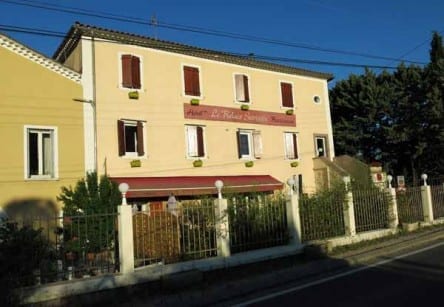
Sunday, 30 June 2013
Distance 17 km
Duration 4 hours 25 minutes
Ascent 169 m, descent 212 m
Map 163 of the TOP100 lime-green series
Topoguide (Ref 7000) Le chemin de Régordane
Although we had declined breakfast in the hotel on the grounds that we would be leaving before 7 (but actually because it was too expensive), we did not get downstairs until somewhat later.

Only one of our three hosts was in evidence, serving a few early risers in the dining room, and we shook his hand warmly as we left. Our plan was to have breakfast down the road at the Bon Accueil.
When we got there, the gate to the back garden, where we had eaten last night, was locked and the action was in the bar at the front, where morning sunlight washed in onto the creamy stonework of the walls.

There were already several drinkers at the counter. Unfortunately there were no croissants to go with the coffee, but we were confident of getting a more substantial second breakfast at one of the villages further on.
To get back onto the GR required a short walk on the highway to a crossroads, then a bit of trial and error amongst small streets and over an earth bank, and finally another few minutes along a road.

The GR, coming down from the heights of Vézénobres, was a well-worn, well-graded, stony track (with all the attributes of the real Régordane), along a wooded slope, with vines in the flat land below.
It descended and became a bitumen road before we arrived at the entrance to Ners. Here the GR turned away, but we continued into the village, unattractively new as it looked, in search of refreshment, although it was hardly more than an hour since our first coffee.
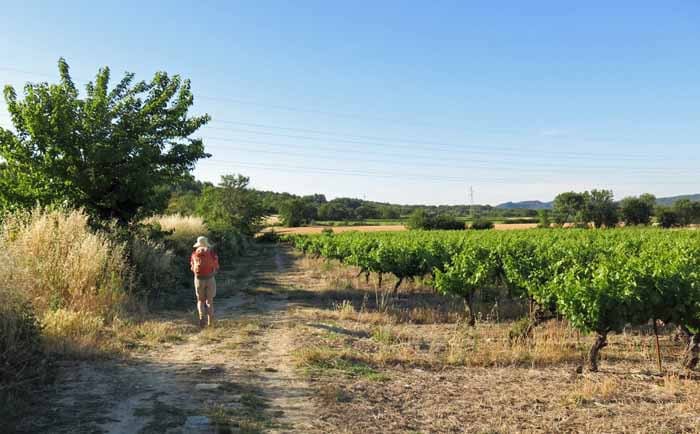
As we penetrated further into Ners, the streets became small and stony and twisted, falling steeply towards the river.
We should not have been surprised at its mediaeval appearance, because we knew that Ners had been the traditional river crossing point of the Régordane, which had then continued along the right bank of the Gardon, through Boucoiran and St-Geniès-de-Malgoirès to la Calmette.
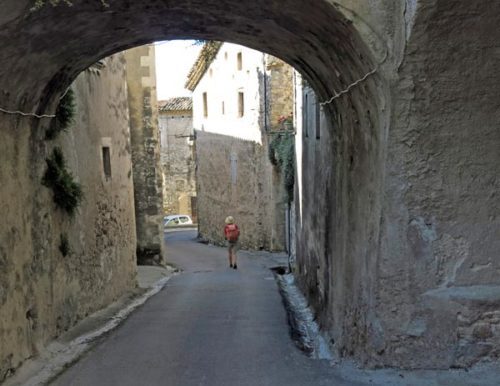
By contrast, the modern GR700 takes a more circuitous route on the left bank, probably because the mighty N106 has swallowed up all the suitable small roads and tracks on its side of the river.
At the very bottom of the village we found a boulangerie, where we got some bread and the information that the nearest bar was across the bridge – not the direction that we were going.
We had hopes of the bar at Brignols, so we were not too dashed, and decided to press on. Rather than retracing our steps to the top of the town, we took the small road beside the river and rejoined the GR at Cruviers-Lascours.
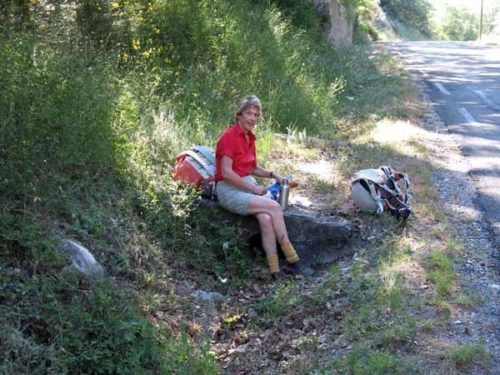
It was an easy and uneventful walk. Half way along, we stopped for a bite of sustenance, consisting of our newly-bought bread, with ham and mustard that we had saved from last night’s dinner.
When we finally turned away from the river and found the GR, we took an old road straight up and over a hill, leaving the modern road to circle around its base.
On the other side we came down into the streets of Cruviers-Lascours and were grateful for the GR signs to guide us through the maze.
A municipal park, a sports field and a huge, fenced-off distillery made for crooked progress, but we eventually got out into open land, where a wheel track across a slope planted with vines took us the short distance to Brignon.
Brignon was a very pretty old village on a promontory overlooking the river, full of archways, cobbled lanes, a fine church and so on, but it had one great fault – the bar no longer existed. It had been there when the Topoguide was written in 2008, but five years later there was no trace of it. We were not as philosophical about this as we had been about the lack of a bar at Ners, but there was nothing for it but to continue.

Descending dramatically from the church, we got onto the D7 and crossed the Gardon at last, on a long bridge that hinted at the possibility of massive floods, although at the moment the river was flowing tamely within its bed, between wide water meadows.
We were now off the GR again, and the rest of the way to our destination was on bitumen. First we crossed the railway line, then turned left and went uphill until we reached the fearsome new section of the N106, which had an underpass for our little road.
After that we kept climbing and soon got to the unprepossessing outskirts of Sauzet – raw new houses on bare blocks for the most part.
The old centre of Sauzet was on the crest of the hill to our right, but our road just skirted around it. We were getting tired by then (it was nearly midday) and had no wish to delay our arrival at the hotel at St-Geniès-de-Malgoirès, so we trudged on.

The road swept down and curved around a wood, after which there was a beautiful prospect of St-Geniès-de-Malgoirès not far away across the fields. We passed an enormous cemetery where the dead were housed in rows of windowless cottages, better accommodation than many of the living in some parts of the world. At the station we crossed the tracks and walked quite a long way before we came to the centre of town.
It looked a good deal livelier than it had on our last visit, even though it was Sunday. The tree-shaded circular main square was lined with bars and shops. Like most villages on the Régordane it had a bloody history, especially in the Camisard Wars of the early eighteenth century, in which the Protestant communities of the Cévennes were ultimately forced to submit to the might of the Catholic French crown. Some important meetings between the warring sides were held in St-Geniès-de-Malgoirès.
We had to ask someone to direct us to the hotel l’Esquielle – it was around the S-bend, he said, just off the square. When we stepped through the wide, arched front door, our host was slightly taken aback.

He had evidently not expected us to arrive so early (it was 12:30 pm) and our room was not ready, so he ushered us into a beautiful walled garden at the back, shaded by umbrellas and Mediterranean pines, and brought water, coffee and dark chocolates to keep us happy, which we certainly were.
Our labours were over for the day and we looked forward to a classy meal in the evening.
Our room looked out over this courtyard garden, which sat between the original stone building of the hotel and the new wall on the other side. There was also a pool at the far end, but we were too lazy to use it.
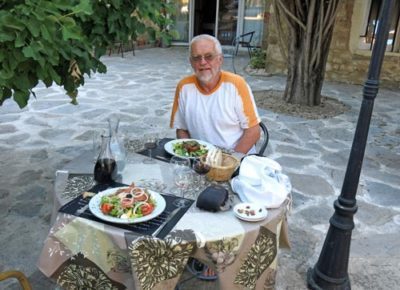
We had showers, then lunch (the rest of the bread plus half a lamb chop from last night), and spent the rest of the afternoon in our clean clothes, watching the Tour from our pillows.
Dinner was in the courtyard, which was full of the pleasant buzz of conversation as the guests enjoyed the mild evening air and the elegant surroundings. We began with apéritifs before launching ourselves into the €19 menu.
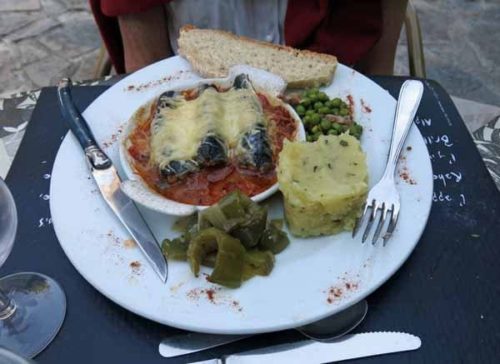
Our entrées were salads, one with smoked salmon and the other with a stack of roasted aubergine.
This was followed by a boeuf bourguignon and a Provençal gratin of sardines, both beautifully garnished.
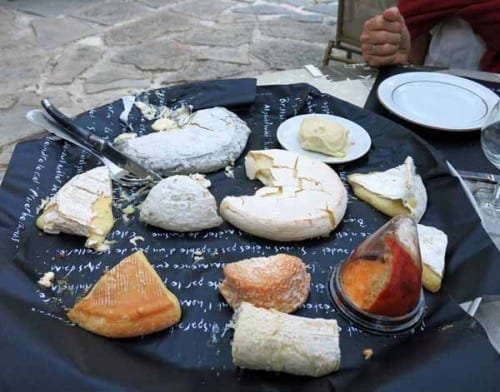
The cheese board appeared in all its magnificence, and Keith finished with a Crème catalan (the southern influence creeping into the cuisine), but I just had a small black coffee and a black chocolate.
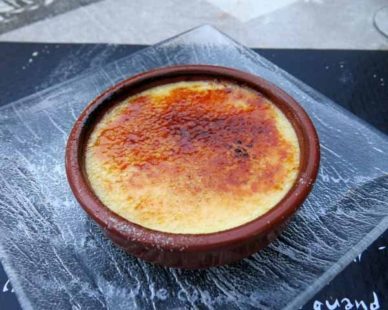
It was a memorable meal, made all the more so by the fact that Keith paid for it, as part of my long-drawn-out birthday celebrations.
Previous day: Alès to Vézénobres